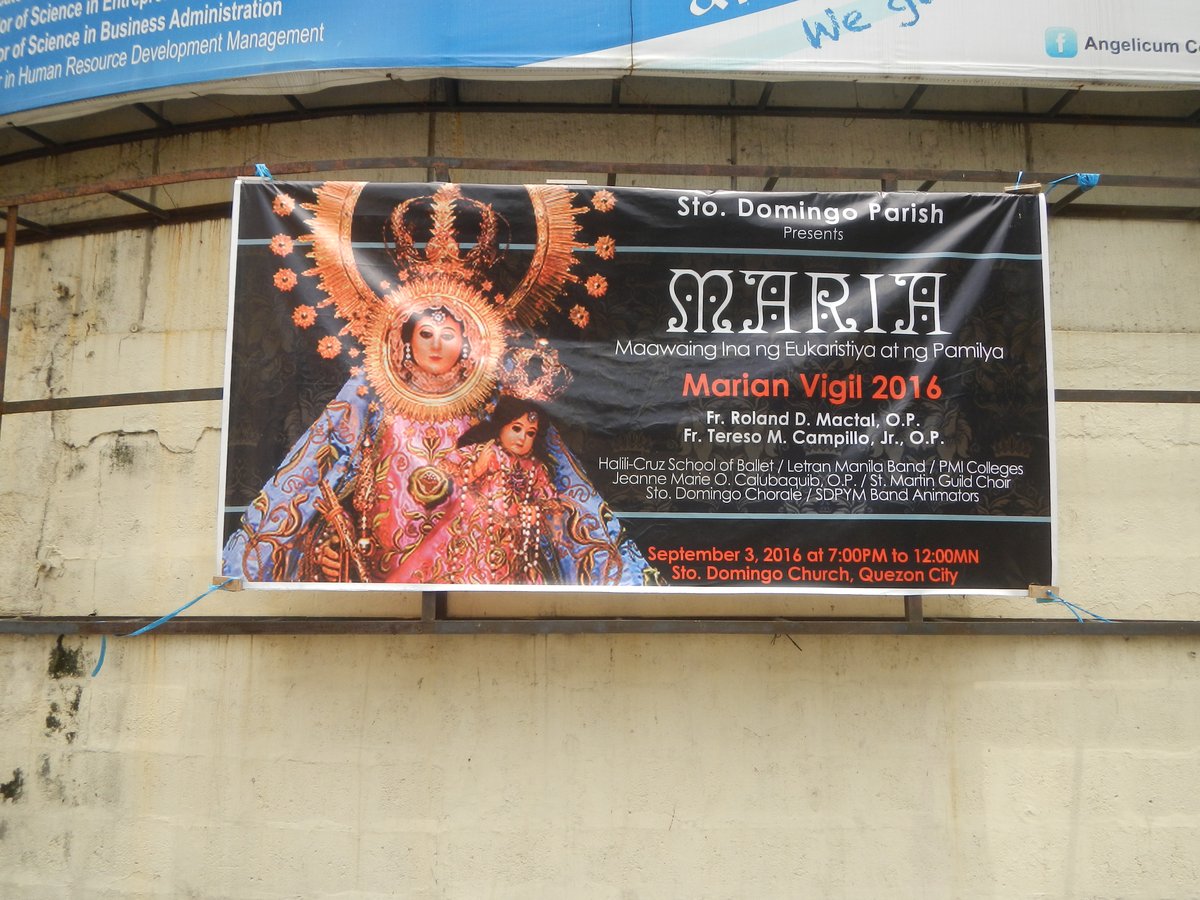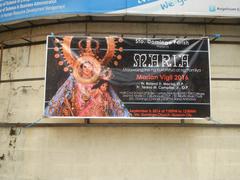
Santo Domingo Church, Metro Manila: Visiting Hours, Tickets, and Historical Guide
Date: 15/06/2025
Introduction: Santo Domingo Church’s Heritage and What to Expect
Situated along Quezon Avenue in the vibrant heart of Quezon City, Santo Domingo Church—officially the National Shrine of Our Lady of the Holy Rosary of La Naval de Manila and Saint Martín de Porres: Parish of St. Dominic de Guzman—stands as the largest church in Metro Manila and a beacon of Filipino faith, artistry, and resilience. Honored as a National Cultural Treasure, this iconic site traces its roots to the arrival of the Dominican Order in the Philippines in 1587, evolving through six incarnations shaped by natural disasters and war. The current structure, completed in 1954, is a modernist masterpiece by National Artist José María Zaragoza, harmonizing Spanish Moderne, Art Deco, and Filipino artistic traditions.
Within its walls, visitors encounter a living gallery of Philippine religious art—including revered works by Carlos “Botong” Francisco, Galo Ocampo, and Francesco Monti—while the adjacent Museo de Santo Domingo preserves artifacts from the original Intramuros church. At the spiritual core of the church is the venerated ivory statue of Our Lady of La Naval de Manila, a symbol of faith and Filipino identity.
This comprehensive guide provides essential information on Santo Domingo Church’s history, visitor hours, ticketing, guided tours, accessibility, and nearby attractions, tailored for pilgrims, tourists, and cultural enthusiasts. For up-to-date details, visit the official Santo Domingo Church website and the Quezon City tourism page.
Table of Contents
- Introduction
- Early Foundations and the Dominican Order
- Destruction, Rebirth, and Relocation
- Architectural Features and Innovations
- Artistic Highlights and Iconography
- The Image of Our Lady of La Naval de Manila
- Visiting Information: Hours, Tickets, and Tips
- Museo de Santo Domingo
- Nearby Attractions and Photographic Spots
- Cultural and Religious Significance
- Practical Tips for Visitors
- Frequently Asked Questions (FAQ)
- Conclusion and Further Reading
Early Foundations and the Dominican Order in the Philippines
Santo Domingo Church was born from the mission of the Dominican Order, which arrived in the Philippines in 1587. The first church, established in 1588 within Intramuros, Manila’s historic walled city, was a simple structure of nipa and bamboo, dedicated to Our Lady of the Rosary—a devotion spread across Asia by the Dominicans (source). Over centuries, this church became a center for missionary activity, education, and Catholic devotion.
Destruction, Rebirth, and Relocation
Throughout its history, Santo Domingo Church has been rebuilt six times, its previous incarnations succumbing to fires, earthquakes, and, most notably, the devastation of World War II. The destruction of the grand Intramuros church in 1941 prompted the Dominicans to relocate to Quezon City. The new church, inaugurated in 1954, symbolized a fresh chapter, blending Filipino adaptability with cutting-edge architectural design (Varsitarian).
Architectural Features and Innovations
Modernist Design with Spanish Moderne and Art Deco Influences
National Artist José María Zaragoza’s design marked a departure from the traditional Baroque, instead embracing a synthesis of Spanish Moderne and Art Deco elements (Wikipedia). The immense façade, geometric planes, and corbel-arched eaves project depth and monumentality (Manila News). Reinforced concrete construction allows for a vast, column-free nave, accommodating thousands and ensuring unobstructed views.
Notable Exterior Features
- Façade and Bell Tower: The minimalist façade is adorned with a high-relief frieze by Italian sculptor Francesco Monti, illustrating the story of La Naval de Manila (Lakad Pilipinas).
- Bas-reliefs and Sculptures: Monti’s reliefs narrate the Battle of La Naval and Dominican history, forming a visual catechism and dramatic entrance to the church.
Artistic Highlights and Iconography
Interior Artworks
- Murals and Dome: Eight expansive dome murals by Carlos “Botong” Francisco depict the lives and virtues of Dominican saints (Varsitarian).
- Stained Glass Windows: Galo Ocampo’s windows illustrate the 15 Mysteries of the Rosary, Dominican milestones, and Filipino Catholic identity, creating a kaleidoscope of light and color (Wikipedia).
- Pipe Organ: Crafted in Hong Kong by Fray Gregorio Hontomin, OP, and restored by Diego Cera Organ Builders, the 1954 pipe organ is a musical and architectural treasure (The Happy Trip).
The Image of Our Lady of La Naval de Manila
The centerpiece is the 17th-century ivory and wood statue of Our Lady of La Naval de Manila. Crafted by Chinese artisans under Dominican supervision, this Marian image is credited with miraculous intercession during the 1646 naval battles, embodying centuries of Filipino Catholic devotion (lakansining.wordpress.com). Each October, the La Naval de Manila festival draws thousands for processions and novenas (findglocal.com).
Visiting Information: Hours, Tickets, and Tips
- Location: 537 Quezon Avenue, Quezon City (Quezon City Government)
- Visiting Hours: Open daily from 5:00 AM to 8:00 PM (hours may vary during events)
- Mass Schedule: Daily Masses at 6:00 AM, 8:00 AM, 12:00 NN, 5:00 PM, and 6:30 PM (Mass Schedules)
- Admission: Free; donations are welcome
- Guided Tours: Available via prior arrangement through the parish office or Museo de Santo Domingo
- Accessibility: Wheelchair-friendly, ramps, restrooms, and designated seating
- Contact: Santo Domingo Church official website
Museo de Santo Domingo
Adjacent to the main church, the museum preserves artifacts from the original Intramuros church, including religious relics, liturgical vestments, and historic documents (The Happy Trip). Museum visits can be coordinated with guided tours for deeper context.
Nearby Attractions and Photographic Spots
- Quezon Memorial Circle: A national park and landmark nearby
- University of the Philippines Diliman: A cultural and educational hub
- SM North EDSA: A premier shopping destination
Photography is best during early morning or late afternoon. Notable spots include the façade, stained glass windows, dome murals, and peaceful courtyards (Trip.com).
Cultural and Religious Significance
Designated as a National Cultural Treasure in 2012, Santo Domingo Church is central to the Dominican Order’s mission and the annual La Naval festivities. It is a living monument to Filipino faith, resilience, and artistry, and a premier venue for sacraments and religious celebrations (Varsitarian).
Practical Tips for Visitors
- Dress modestly (shoulders and knees covered)
- Observe silence inside, especially during Mass
- Photography is permitted, but avoid flash and tripods during services and in the museum
- Plan ahead for large events (like La Naval) due to crowds and parking limitations
- Explore the museum for a richer historical experience
- Combine your visit with other Quezon City attractions (Quezon City Government)
Frequently Asked Questions (FAQ)
Q: What are the Santo Domingo Church visiting hours?
A: The church is open daily from 5:00 AM to 8:00 PM; check ahead for special event schedules.
Q: Is there an entrance fee or ticket required?
A: Admission is free; donations are appreciated.
Q: Are guided tours available?
A: Yes, by appointment through the parish office or Museo de Santo Domingo.
Q: Is Santo Domingo Church wheelchair accessible?
A: Yes, with ramps and designated seating.
Q: Can I take photographs inside the church and museum?
A: Yes, but flash and tripods are restricted during services and inside the museum.
Q: When is the best time to visit?
A: Early mornings on weekdays for a quieter experience; October for the vibrant La Naval festival.
Conclusion and Further Reading
Santo Domingo Church is more than a place of worship—it is a living museum of faith, art, and Filipino heritage. Whether you are a devotee, art lover, or curious traveler, it offers a profound journey into the heart of Philippine history and spirituality. Plan your visit using the tips above and immerse yourself in one of Quezon City’s most significant landmarks.
For schedules, updates, and guided tours, visit the official Santo Domingo Church website and the Santo Domingo Church Facebook page. Download the Audiala app for audio tours and real-time notifications about events and heritage sites.
Key References & Further Reading
- National Museum of the Philippines
- Vigattin Tourism
- Lakansining Wordpress
- The Happy Trip
- Quezon City Government
- Santo Domingo Church Official Website
- Santo Domingo Church Facebook Page




































































